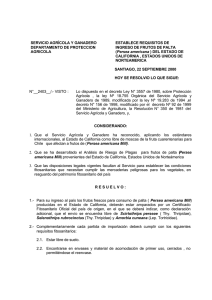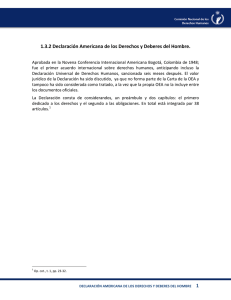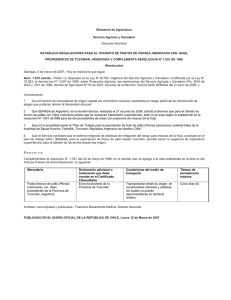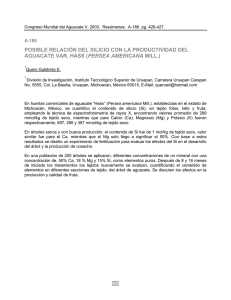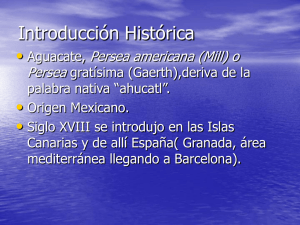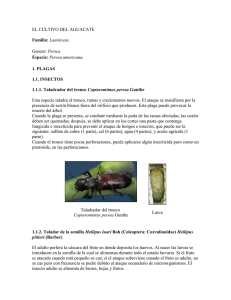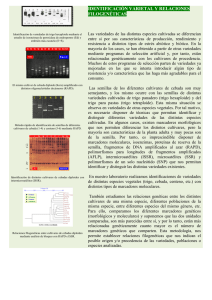Distinción de especies del género Persea mediante RAPD e ISSR
Anuncio
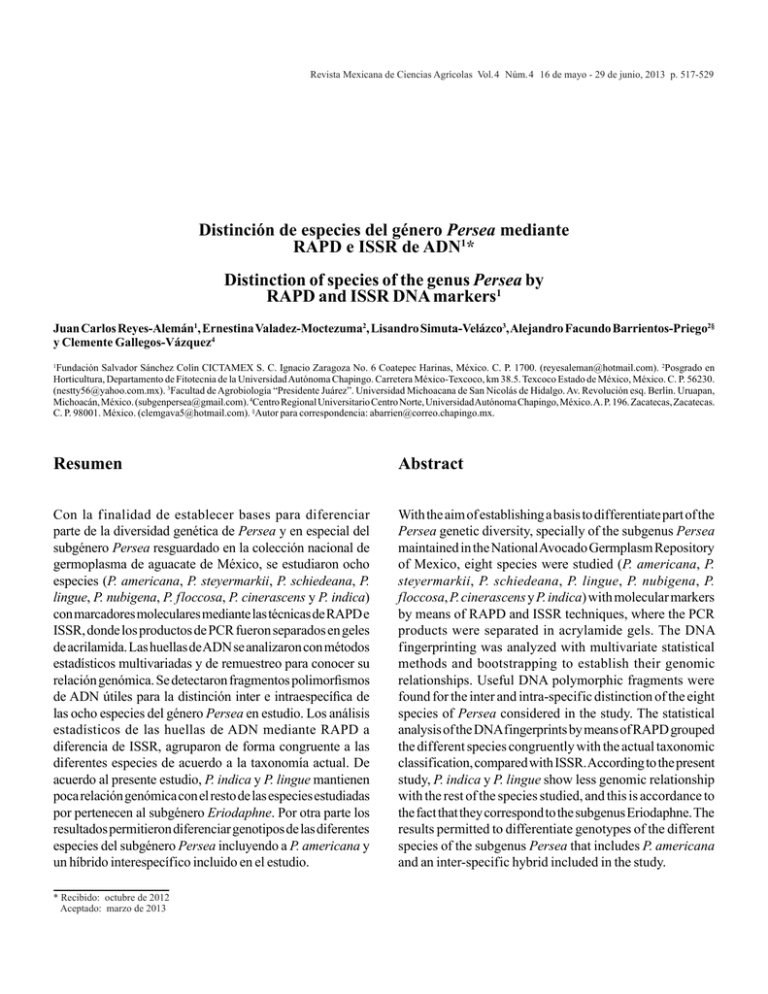
Revista Mexicana de Ciencias Agrícolas Vol.4 Núm. 4 16 de mayo - 29 de junio, 2013 p. 517-529 Distinción de especies del género Persea mediante RAPD e ISSR de ADN1* Distinction of species of the genus Persea by RAPD and ISSR DNA markers1 Juan Carlos Reyes-Alemán1, Ernestina Valadez-Moctezuma2, Lisandro Simuta-Velázco3, Alejandro Facundo Barrientos-Priego2§ y Clemente Gallegos-Vázquez4 Fundación Salvador Sánchez Colín CICTAMEX S. C. Ignacio Zaragoza No. 6 Coatepec Harinas, México. C. P. 1700. ([email protected]). 2Posgrado en Horticultura, Departamento de Fitotecnia de la Universidad Autónoma Chapingo. Carretera México-Texcoco, km 38.5. Texcoco Estado de México, México. C. P. 56230. ([email protected]). 3Facultad de Agrobiología “Presidente Juárez”. Universidad Michoacana de San Nicolás de Hidalgo. Av. Revolución esq. Berlín. Uruapan, Michoacán, México. ([email protected]). 4Centro Regional Universitario Centro Norte, Universidad Autónoma Chapingo, México. A. P. 196. Zacatecas, Zacatecas. C. P. 98001. México. ([email protected]). §Autor para correspondencia: [email protected]. 1 Resumen Abstract Con la finalidad de establecer bases para diferenciar parte de la diversidad genética de Persea y en especial del subgénero Persea resguardado en la colección nacional de germoplasma de aguacate de México, se estudiaron ocho especies (P. americana, P. steyermarkii, P. schiedeana, P. lingue, P. nubigena, P. floccosa, P. cinerascens y P. indica) con marcadores moleculares mediante las técnicas de RAPD e ISSR, donde los productos de PCR fueron separados en geles de acrilamida. Las huellas de ADN se analizaron con métodos estadísticos multivariadas y de remuestreo para conocer su relación genómica. Se detectaron fragmentos polimorfismos de ADN útiles para la distinción inter e intraespecífica de las ocho especies del género Persea en estudio. Los análisis estadísticos de las huellas de ADN mediante RAPD a diferencia de ISSR, agruparon de forma congruente a las diferentes especies de acuerdo a la taxonomía actual. De acuerdo al presente estudio, P. indica y P. lingue mantienen poca relación genómica con el resto de las especies estudiadas por pertenecen al subgénero Eriodaphne. Por otra parte los resultados permitieron diferenciar genotipos de las diferentes especies del subgénero Persea incluyendo a P. americana y un híbrido interespecífico incluido en el estudio. With the aim of establishing a basis to differentiate part of the Persea genetic diversity, specially of the subgenus Persea maintained in the National Avocado Germplasm Repository of Mexico, eight species were studied (P. americana, P. steyermarkii, P. schiedeana, P. lingue, P. nubigena, P. floccosa, P. cinerascens y P. indica) with molecular markers by means of RAPD and ISSR techniques, where the PCR products were separated in acrylamide gels. The DNA fingerprinting was analyzed with multivariate statistical methods and bootstrapping to establish their genomic relationships. Useful DNA polymorphic fragments were found for the inter and intra-specific distinction of the eight species of Persea considered in the study. The statistical analysis of the DNA fingerprints by means of RAPD grouped the different species congruently with the actual taxonomic classification, compared with ISSR. According to the present study, P. indica y P. lingue show less genomic relationship with the rest of the species studied, and this is accordance to the fact that they correspond to the subgenus Eriodaphne. The results permitted to differentiate genotypes of the different species of the subgenus Persea that includes P. americana and an inter-specific hybrid included in the study. * Recibido: octubre de 2012 Aceptado: marzo de 2013 Juan Carlos Reyes-Alemán et al. 518 Rev. Mex. Cienc. Agríc. Vol. 4 Núm. 4 16 de mayo - 29 de junio, 2013 Palabras clave: germoplasma, marcadores moleculares, recursos fitogenéticos. Key words: Lauraceae, avocado, germplasm, molecular markers, plant genetic resources. Introducción Introduction México cuenta con amplia variabilidad en aguacate y existen en el al menos 20 diferentes especies relacionadas con el aguacate (Barrientos et al., 2007). El género Persea que pertenece a la familia Lauraceae es considerado como uno de los más difíciles de abordar taxonómicamente (Kopp, 1966). Hace unos años se publicó que el subgénero Persea sólo está formado por P. americana y P. schiedeana, dejando fuera a P. nubigena, P. steyermarkii, P. parvifolia, P. tolimanensis, P. floccosa, y P. zentmyerii, y se indicó que la variabilidad en aguacate se debe a los procesos de selección y cultivo que el hombre ha hecho a través del tiempo (Van der Werff, 2002). Mexico has a large variety of avocados, with at least 20 different species (Barrientos et al., 2007). The genus Persea, which belongs to the family Lauraceae, is considered one of the most difficult to classify taxonomically (Kopp, 1966). A few years ago it was reported that the subgenus Persea comprises only P. americana and P. schiedeana, leaving out P. nubigena, P. steyermarkii, P. parvifolia, P. tolimanensis, P. floccosa, and P. zentmyerii, and it was also indicated that the variability in avocado is due to the selection and cultivation processes carried out by man over time (van der Werff, 2002). RFLP allowed to separate P. nubigena, P. steyermarkii and P. floccosa from P. americana (Furnier et al., 1990); however, it was indicated that they might be variants of P. americana. Recently, it was suggested that the subgenera Persea and Eriodhapne should be considered as genera, based on an algorithmic parsimony analysis (Campos et al., 2006), which also recognizes most of the species of the subgenus Persea. The difficulties found in the classification of the races of avocado are due to, along with the influence of man, the extreme variability of their progeny (Gama, 1994), so that tools such as molecular markers could have a direct application to solve the taxonomic problem of assigning a location for avocado within the complex Persea. There already precedents for avocado with RFLP (Davies et al., 1998), SSR (Mhameed et al., 1997), RAPD (Fiedler et al., 1998), AFLP (Chao et al., 2003) and microsatellites (Ashworth and Clegg, 2003). If the RAPD- based assays are carried out under strict and standardized conditions, it is possible to perform tests quickly and less technically demanding compared to minisatellites and microsatellites (Fiedler et al., 1998). Furthermore, these same authors indicated that RAPD may help elucidate the genetic variation of the entire subgenus Persea, as the presence of specific monomorphic fragments for each race of P. americana was demonstrated by this method, a finding that microsatellites have not been able to achieve (Schnell et al., 2003). Mediante RFLP se pudo separar P. nubigena y P. steyermarkii y a P. floccosa de P. americana (Furnier et al., 1990); sin embargo, indicó que pueden ser solo variantes de P. americana. Recientemente se planteó que los subgéneros Persea y Eriodhapne se consideren como géneros, basado en un análisis de parsimonia algorítmica (Campos et al., 2006), donde también reconoce a la mayoría de las especies del subgénero Persea. Las dificultades en la clasificación de las razas de aguacate, junto con la influencia del hombre, es el hecho de que su progenie es extremadamente variable (Gama, 1994), por lo que las herramientas como los marcadores moleculares podría tener una aplicación directa para resolver la ubicación taxonómica dentro del complejo Persea, existen ya antecedentes en aguacate con RFLP (Davies et al., 1998), con SSR (Mhameed et al., 1997), con RAPD (Fiedler et al., 1998), con AFLP (Chao et al., 2003) y con microsatélites (Ashworth y Clegg, 2003). Si se dan las condiciones estandarizadas y estrictas a lo ensayos con marcadores basados en RAPD, se pueden realizar pruebas rápidas y de menor demanda técnica, comparados con minisatélites y microsatélites (Fiedler et al., 1998). Asimismo, estos mismos autores indicaron que los RAPD pueden ayudar a elucidar la variación genética de todo el subgénero Persea, ya que se demostró la detección de fragmentos monomórficos específicos para cada raza de P. americana, lo cual no se ha encontrado con microsatélites (Schnell et al., 2003). Distinción de especies del género Persea mediante RAPD e ISSR de ADN1 519 Por lo anterior se planteó como objetivo, establecer las bases para la distinción mediante marcadores moleculares de genotipos representativos del subgénero Persea y Eriodaphne, con énfasis en el primero. Therefore, we proposed as the objective of this study to distinguish, by way of molecular markers, representative genotypes of the subgenera Persea and Eriodaphne, especially of the former. Materiales y métodos Materials and methods En el presente estudio se realizó durante 2008, un total de 14 genotipos de Persea fueron evaluados, provenientes del banco de germoplasma de la Fundación Salvador Sánchez Colín CICTAMEX, S.C. localizado en Coatepec Harinas, Estado de México, México. Correspondiendo a ocho especies del género Persea: P. americana, P. steyermarkii, P. schiedeana, P. lingue, P. nubigena, P. floccosa, P. cinerascens, P. indica, posible híbrido P. nubigena x P. americana y un híbrido P. schiedeana x P. americana var. guatemalensis (Cuadro 1). The present study was conducted during 2008; a total of 14 genotypes of Persea were evaluated, all them from the Germplasm Bank of the Salvador Sánchez Colin Foundation, CICTAMEX , S. C., located in Coatepec Harinas, State of Mexico, Mexico. The genotypes correspond to eight species of the genus Persea: P. americana, P. steyermarkii, P. schiedeana, P. lingue, P. nubigena, P. floccosa, P. cinerascens, P. indica, the possible hybrid P. nubigena x P. americana and a hybrid, P. schiedeana x americana var. guatemalensis (Table 1). Cuadro 1. Genotipos de Persea tipificados mediante RAPD e ISSR en el estudio. Table 1. Persea genotypes typified using RAPD and ISSR in the study. Origen España México Guatemala México Guatemala Guatemala México México México México México México Honduras Chile Nombre designado Indica Canelillo Gigantea Floccosa Nubigena 1/7 Martín Grande c ScrMer 7 S1 Rodeo 1 CRM Olanca 2 S3 Tochimilco 1 Steyermarkii Lino Lingue Núm. en lote 1 2 3 10 12 19 60 70 76 114 208 232 44 32 Especie, raza o parentesco P. indica P. cinerascens P. gigantea P. floccosa Posible híbrido P. nubigena x P. americana Híbrido P. schiedeana x P. americana var. guatemalensis P. americana var. guatenmalensis P. nubigena P. americana var. drymifolia P. americana var. guatenmalensis P. americana var. drymifolia P. steyermarkii P. shiedeana P. lingue ScrMer 7 S1= San Cristóbal de las Casas Mercado 7 Semilla 1; CRM= Criollo de la Raza Mexicana. Extracción de ADN DNA extraction Basándose en el método del CTAB (“cetyltrimethylammonium bromide”) conforme en los protocolos ya establecidos (Saghai-Maroof et al., 1984), con leves modificaciones, se realizó la extracción de ADN de hojas frescas de aguacate de los genotipos correspondientes. Posteriormente el ADN obtenido se almacenó a 4 °C hasta su uso. We extracted DNA from fresh leaves of avocado of the corresponding genotypes based on the CTAB method ("cetyltrimethylammonium bromide") and according to established protocols slightly modified (Saghai-Maroof et al., 1984).Subsequently, the DNA obtained was stored at 4 °C until use. Juan Carlos Reyes-Alemán et al. 520 Rev. Mex. Cienc. Agríc. Vol. 4 Núm. 4 16 de mayo - 29 de junio, 2013 Condiciones de PCR PCR conditions Mediante la técnica de la reacción de polimerización en cadena (PCR) se sintetizaron in vitro fragmentos específicos de ADN con la finalidad de detectar mediante el uso del termociclador secuencias específicas en el genoma de hojas de aguacate. Se usó para RAPD e ISSR un equipo Gene Amp PCR System 2700. Para RAPD el programa de termociclaje comprendió un ciclo inicial de desnaturalización de 1´00´´ a 94 °C, 35 ciclos comprendiendo la desnaturalización, alineamiento y extensión de 0´30´´ a 94 °C, 0´30´´ a 40 °C y 1´30´´ a 72 °C, respectivamente, y al final 1 ciclo de extensión de 2´30´´ a 72 °C. Para ISSR se utilizó un ciclo inicial de desnaturalización de 1´00´´ a 94 °C, 38 ciclos comprendiendo desnaturalización, alineamiento y extensión de 0´30´´ a 94 °C, 0´30´´ a 48 °C y 2´00´´ a 72 °C, respectivamente, y al final 1 ciclo de extensión de 2´30´´ a 72 °C. Using the polymerase chain reaction (PCR) technique, we synthesized in vitro specific DNA fragments with the aim of detecting, with the use of the thermocycler, specific sequences in the genome of avocado leaves. For RAPD and ISSR, we used a Gene Amp PCR System 2700 equipment. For RAPD, the thermocycling program included an initial denaturation cycle of 1' 00'' at 94 °C, with 35 cycles comprising denaturation, alignment and extension of 0' 30'' at 94 °C, 0' 30'' at 40 °C, and 1' 30'' at 72 °C, respectively; and at the end, one extension cycle of 2' 30'' at 72 °C. For ISSR we used an initial denaturation cycle of 1' 00'' at 94 °C, with 38 cycles comprising denaturation, alignment and extension of 0' 30'' at 94 °C, 0' 30'' at 48 °C and 2' 00'' at 72 °C, respectively, and at the end one extension cycle of 2' 30'' at 72 °C. The reaction components for the RAPD analysis were placed in 500 µl tubes, each containing 25 µl of the following components: 5 µl of DNA (20 ng µl-1), 0.3 µl of the Taq polymerase enzyme (5 U µl-1), 10 ml DNTPs (500 µM), 2.5 µl of Taq buffer (1x), 2 µl of MgCl2 (25 mM), 2 µl of primer and 3.2 µl of water. The reaction components for the ISSR analysis were the same as were used for RAPD but in this case the quantities used were: 2.5 µl of DNA [20 ng µl-1] and 3 µl of MgCl2 [25 mM]. Seven primers were used for RAPD (Table 2) and five for ISSR (Table 3). Los componentes de reacción para el análisis tipo RAPD se colocaron en tubos de 500 µl conteniendo cada uno 25 µl de los siguientes componentes; 5 µl de ADN (20 ng µl-1), 0.3 µl enzima Taq polimerasa (5 U µl-1), 10 ml DNTPs (500 µM), 2.5 µl amortiguador Taq (1x), 2 µl de MgCl2 (25 mM), 2 µl de Primer y 3.2 µl de agua. Los componentes de reacción para el análisis tipo ISSR fueron los mismos que se utilizaron para RAPD solo que en este caso se utilizaron; 2.5 µl de ADN [20 ng µl-1] y 3 µl de MgCl2 [25 mM]. Se utilizaron siete iniciadores para el caso de RAPD (Cuadro 2) y cinco para ISSR (Cuadro 3). Cuadro 2. Iniciadores RAPD utilizados e información de fragmentos de ADN de genotipos de Persea spp. Table 2. RAPD primers used and information about the DNA fragments of genotypes of Persea spp. Secuencia de iniciador 5´-TTC CGA ACC C-3´ Fragmentos detectados 15 Fragmentos Polimórficos (%) 80.0 Fragmentos de individuales entre genotipos 3 5´-TGT CTG GGT G-3´ 48 83.3 8 5´-AAG CCT CGT C-3´ 43 93.0 3 5´-TGG ACC GGT G-3´ 51 88.2 6 5´-TGC GGC TGA G-3´ 61 90.1 6 5´-GGT GAC TGT G-3´ 68 94.1 4 5´-GGA CTG CAG A-3´ 53 92.4 4 Distinción de especies del género Persea mediante RAPD e ISSR de ADN1 521 Cuadro 3. Iniciadores ISSR utilizados e información de fragmentos de ADN de genotipos de Persea spp. Table 3. ISSR primers used and information about the DNA fragment of genotypes of Persea spp. Secuencia de Iniciadorz 5´-(AC)8YG-3´ 5´-(GA)8YC-3´ 5´-(TCC)5RY-3´ 5´-(GACA)4-3´ 5´-(GATA)4-3´ Fragmentos de detectados 25 26 19 18 17 Y sustituye residuos C (citosina) y T (timina); R sustituye G (guanina) y A (adenina). Fragmentos Polimórficos (%) 80.0 93.3 89.4 83.3 88.2 Fragmentos de individuales entre genotipos 5 2 2 3 2 z Elaboración de geles Preparation of gels Los productos amplificados de PCR se separaron mediante electroforesis con una cámara en sistema vertical mediante geles de poliacrilamida 8%. Para el corrimiento de las muestras se utilizaron 2.5 µl de la mezcla del producto de la reacción de PCR agregando 1 µl de buffer de carga “blue orange” y se utilizó un marcador estándar de 1 Kb. Los geles se corrieron a 280 volts por 2.5 h en amortiguador TBE 1X y se tiñeron con AgNO3 0.2% de acuerdo al protocolo convencional. Para la documentación de las huellas de ADN se utilizó el sistema Digital Science 1D V.2.0.3. The PCR amplified products were separated by electrophoresis with a camera mounted on a vertical system using 8% polyacrylamide gels. 2.5 µl of the mixture produced by the PCR reaction were used for running the samples, adding 1 µl of loading buffer "blue orange", and using a standard 1 Kb marker. The gels were run at 280 volts for 2.5 h in TBE 1X buffer and stained with 0.2% AgNO3 according to the conventional protocol (Valadez and Kahl, 2000).The Digital Science 1D system, V.2.0.3, was used for recording the DNA fingerprints. Statistical analysis Análisis estadístico Mediante los perfiles de bandas obtenidos en los geles se elaboró una matriz básica de datos correspondiente a cada iniciador utilizado, donde la presencia y ausencia de bandas fue registrado, asignando 1 y 0, respectivamente. Para el análisis de los datos obtenidos y agrupados en cada matriz, respectiva, se utilizó el criterio de distancias de similitud mediante el índice Jaccard (Jaccard, 1908) y para el agrupamiento se utilizó el método Neighbor-Joining recomendado para generar grupos por similitud (Saitou y Nei 1987), este método ha sido utilizado con RAPD en germoplasma de cacao (Whitkus et al., 1999) y RAPD para germoplasma de yuca (Manihot esculenta Crantz) donde se comprobó que el mejor método de agrupamiento fue NeighborJoining con valores del índice de Jaccard (Demey et al., 2003). Para elaborar el árbol se utilizó el programa FreeTree v. 0.9.1.50 (Pavlícek et al. 1999), y se realizó un remuestreo (“bootstrapp”) de 1000 repeticiones, obteniendo el árbol consenso con las frecuencias de cada uno de los agrupamientos (Hampl et al. 2001), para visualizar el árbol obtenido se utilizó el programa Tree View v. 1.6.6 (Page, 1996). From the band profiles obtained with the gels we prepared a basic data matrix for each primer used where we registered the presence and absence of bands, assigning 1 and 0, respectively. To analyze the data collected and grouped in each matrix we used the criteria of similarity distances by way of the Jaccard index (Jaccard, 1908). For grouping we used the Neighbor-Joining method recommended to generate groups by similarity ( Saitou and Nei 1987); this method has been used with RAPD on cocoa germplasm (Whitkus et al., 1999) and on cassava germplasm (Manihot esculenta Crantz), from which it was found that the best grouping method was Neighbor-Joining with values from the Jaccard index (Demey et al., 2003). We used the FreeTree program, v. 0.9.1.50, to make the tree. (Pavlicek et al. 1999), and performed a bootstrap of 1000 replicates, obtaining the consensus tree with the frequencies of each of the groupings (Hampl et al. 2001); to visualize the tree obtained we used Tree View program, v. 1.6.6 (Page, 1996). Juan Carlos Reyes-Alemán et al. 522 Rev. Mex. Cienc. Agríc. Vol. 4 Núm. 4 16 de mayo - 29 de junio, 2013 Resultados y discusión Results and discussion Cada iniciador derivó diversos fragmentos de ADN que sirvieron para generar las dos matrices, tanto con RAPD e ISSR (Figuras 1 y 2). Each primer amplified various DNA fragments which served to generate the two matrices, both with RAPD and with ISSR (Figures 1 and 2). M Gig Cin Stey Floc Chin Nubh Nub Ling Indi Mex Mtoch Gua7 GuaOl Mg M M Gig Cin Stey Floc Chin Nubh Nub Ling Indi Mex Mtoch Gua7 GuaOl Mg M Figura 1. Ejemplo de perfiles de fragmentos derivados de ADN genómico de especies del género Persea mediante RAPD del iniciador 5´-GGT GAC TGT G-3´. Figure 1. Example of amplified genomic DNA fragments of species belonging to the genus Persea using the primer RAPD 5'-GGT GAC TGT G-3'. Figura 2. Ejemplo de perfiles de fragmentos derivados de ADN nuclear de especies del género Persea mediante ISRR del iniciador (GA)8YC. Figure 2. Example of amplified nuclear DNA fragments of species belonging to the genus Persea by ISRR of the primer (GA)8 YC. Dichos fragmentos fueron más abundantes en la mayoría de los iniciadores RAPD (Cuadro 2), mientras que en los ISSR fueron menos abundantes (Cuadro 3); donde todos los iniciadores mostraron 80% o más fragmentos polimórficos. La matriz de datos para RAPD contó con 3 808 caracteres de todos los 14 individuos, mientras que para ISSR la matriz se constituyó de 1 470 caracteres. Dichas matrices fueron utilizadas para derivar árboles filogenéticos (filogramas) para RAPD e ISSR. These fragments were most abundant in most RAPD primers (Table 2), whereas in the ISSR were less abundant (Table 3); in the latter all primers showed 80% or more polymorphic fragments. The overall banding pattern differed markedly between individuals; single bands were detected for each of the individuals, their number varying with RAPD (Table 4); however, with ISSR unique fragments were found for only some individuals. The band patterns detected for all primers were highly informative and distinctive for each of the individuals. The data matrix for RAPD had 3808 characters of all 14 individuals, while for ISSR the matrix consisted of 1470 characters. These matrices were used to derive phylogenetic trees (phylograms) for RAPD and ISSR. Todos los individuos se pudieron diferencias y no existieron redundancias. La distancia genética más lejana para el caso de RAPD fue de 0.875 entre P. schiedeana y P. indica, y la con mayor cercanía fue entre P. nubigena y para el posible híbrido P. nubigena x P. americana con 0.511. Para ISSR la All individuals were different and there were no redundancies. The greatest genetic distance in the case of RAPD was 0 875, between P. schiedeana and P. indica, and the shortest was between P. nubigena and the possible hybrid P. nubigena x P. americana, with 0. 511. For ISSR El patrón de bandeo en general defirió marcadamente entre individuos, donde se detectaron bandas únicas para cada uno de los individuos variando en su número con RAPD (Cuadro 4); sin embargo, para ISSR solo se encontraron fragmentos únicos para algunos individuos. Los patrones de las bandas detectadas para todos los iniciadores fueron altamente informativos y distintivos para cada uno de los individuos. Distinción de especies del género Persea mediante RAPD e ISSR de ADN1 523 distancia genética más lejana fue de 0.903 entre P. gigantea y P. nubigena, mientras que la menor distancia fue para el híbrido P. nubigena x P. americana y P. americana var. drymifolia (“Tochimilco”) con una 0.604. the greatest genetic distance was 0.903 between P. gigantea and P. nubigena, while the shortest was for the hybrid P. nubigena x P. americana and P. americana var. drymifolia ("Tochimilco") with 0.604. Cuadro 4. Genotipos de Persea y fragmentos únicos de ADN genómico detectados mediante RAPD e ISSR. Table 4. Persea Genotypes and unique fragments of genomic DNA detected by RAPD and ISSR. Nombre designado Especie, raza o parentesco Indica Canelillo Gigantea Floccosa Nubigena 1/7 Martín Grande c ScrMer7 S1 Rodeo 1 CRM Olanca2 S3 Tochimilco 1 Steyermarkii Lino Lingue P. indica P. cinerascens P. gigantea P. floccosa Posible híbrido P. nubigena x P. americana Híbrido P. schiedeana x P. americana var. guatemalensis P. americana var. guatenmalensis P. nubigena P. americana var. drymifolia P. americana var. guatenmalensis P. americana var. drymifolia P. steyermarkii P. shiedeana P. lingue Mediante RAPD los individuos formaron una marcada separación inicial que fue entre P. indica y el resto de los individuos, lo cual fue soportado por un alto valor de remuestreo (100%). La siguiente bifurcación fue de P. lingue con el restante de los individuos (Figura 3). La tercera bifurcación formó dos grupos que incluyeron a todo el subgénero Persea, con la excepción de P. cinerascens. En el caso de RAPD la formación de un árbol filogenético resultó en separación y agrupación general conforme a la taxonomía indicada para el subgénero Persea (Williams, 1977) y parcial con la de todo el género Persea (Kopp, 1966). Donde fue marcada la separación de P. indica, especie de las Islas Canarias, España (Kopp, 1966) y que hasta hace unos años era la única Persea fuera de las Américas; sin embargo, se ha indicado la existencia de especies del género Persea en Asia designados dentro del subgénero Machilus (Chanderbali et al., 2001). La separación clara de P. indica fue seguida por la de P. lingue, especie proveniente de Chile, por lo que la separación de estas dos primeras ramas del árbol incluyó a las dos especies del subgénero Eriodaphne del presente estudio, lo cual coincidió en otro estudio donde se dio la separación del subgénero Persea de Eriodaphne con secuencias ITS (Chanderbali et al., 2001); sin embargo, en otro trabajo donde se consideró a 10 especies, tanto del Fragmentos únicos RAPD 1 5 3 2 2 1 2 2 3 1 2 2 3 5 Fragmentos únicos ISSR 3 0 0 1 2 0 1 1 0 1 1 0 1 2 With RAPD, there was an initial separation between P. indica and the rest of the individuals, which was supported by a high bootstrap value (100%). The next bifurcation marked the separation between P. lingue and the rest of the individuals (Figure 3). The third branch formed two groups that included all the subgenus Persea, with the exception of P. cinerascens. In the case of RAPD, the formation of a phylogenetic tree resulted in general separation and grouping according to the taxonomy indicated for the subgenus Persea (Williams, 1977), and partial separation and grouping with respect to the taxonomy of the whole genus Persea (Kopp, 1966). The marks the separation of P. indica, a species of the Canary Islands, Spain (Kopp, 1966), which until recently was the only Persea outside the Americas; however, indicated the existence of species of the genus Persea in Asia has been indicated, assigned to the subgenus Machilus (Chanderbali et al., 2001). The clear separation of P. indica was followed by that of P. lingue, a species from Chile, so that the separation of these two first branches of the tree included the two species of the subgenus Eriodaphne of the present study, which coincided with another study where there was a separation of the subgenus Persea from Eriodaphne with ITS sequences (Chanderbali et al., 2001). However, in another work where 10 species were considered, both of the subgenus Persea (six) Juan Carlos Reyes-Alemán et al. 524 Rev. Mex. Cienc. Agríc. Vol. 4 Núm. 4 16 de mayo - 29 de junio, 2013 subgénero Persea (seis) y Eriodaphne (cuatro), así como las tres razas de aguacate, no se pudo separar los dos subgéneros con marcadores SSR (Mhameed et al., 1997), pero si a P. americana del resto de las especies, y además dentro de P. americana se tuvo clara separación entre las razas. and the subgenus Eriodaphne (four), as well as the three races of avocado, it was not possible to separate the two subgenera using SSR markers (Mhameed et al., 1997), but P. americana could be separated from the rest of the species, and within P. americana a clear separation between the races was obtained. Especie de Islas Canarias Indica Subgénero Eriodaphne Especie de Chile Lingue Gigantea 100 6 Steyermarkii Especies que dieron origen a la raza Guatemalteca 6 Nub 2 89 Nubh Mex 4 P. americana Raza de aguacate Gua7 14 Subgénero Persea GuatOlanca Shiedeana Cinerascens 3 * Martin grande P. schiedeanax P. americana Floccossa 34 0.1 Tochimilco Especies e híbrido interepecifico Especie ancestro de raza Mexicana e híbrido Mex. x Guat. * Especie considerada como del subgénero Eriodaphne pero con características de flor de Persea Figura 3. Filograma de 14 accesiones de Persea obtenido mediante RAPD, considerando un análisis estadístico combinado entre siete iniciadores, utilizando el índice Jaccard y el método Neighbor-joining con un remuestreo de 1 000 repeticiones (“bootstrap”). Figure 3. Phylogram of 14 accessions of Persea obtained by RAPD, considering a combined statistical analysis of seven primers, using the Jaccard index and the Neighbor-joining method with a bootstrap of 1 000 replicates. En el presente estudio tres individuos de Persea americana se agruparon y se pudieron separar, con excepción de “Tochimilco” que se agrupó con Persea floccosa, especie que se piensa es ancestro de Persea americana var. drymifolia (Scora y Bergh, 1990). “Tochimilco” se estudió anteriormente con AFLP y se encontró dentro de un grupo muy específico de aguacates de la raza Mexicana donde se formaron un total de siete grupos de la raza Mexicana con una gran variación genética. Cabe indicar que los posibles antecesores de la raza Guatemalteca (P. americana var. guatemalensis) como P. nubigena (Williams 1977), P. gigantea y P. steyermarkii (Schieber y Zentmyer 1977), se agruparon y se separan del mismo nodo In this study, three individuals were of Persea americana were grouped and could be separated, with the exception of "Tochimilco", which was grouped with Persea floccosa, a species thought to be the ancestor of Persea americana var. drymifolia (Scora and Bergh, 1990). "Tochimilco" was previously studied with AFLP (Chao et al., 1990) and was found to be within a very specific group of avocados of the Mexican race; a total of seven groups of the Mexican race were formed, with a great genetic variation. It is worth noting that the possible ancestors of the Guatemalan race (P. americana var. guatemalensis) such as P. nubigena (Williams 1977), P. gigantea and P. steyermarkii (Schieber and Zentmyer 1977), were grouped together and separated Distinción de especies del género Persea mediante RAPD e ISSR de ADN1 donde se agrupó la raza Guatemalteca, referente a esto, se encontró mediante RFLP evidencia de que P. nubigena y P. steyermarkii pudieron dar origen a P. americana var. guatemalensis (raza Guatemalteca) (Furnier et al., 1990), por lo que su cercanía concuerda con lo encontrado en el presente estudio. La inclusión de P. cinerascens que es del subgénero Eriodaphne contrasta al agruparse con P. schiedeana y el híbrido interespecífico P. schiedeana x P. americana var. guatemalensis, P. schiedeana es la especie más distintiva del subgénero Persea y se ha encontrado que es altamente variable, donde probablemente existen razas dentro de P. schiedaena (Barrientos et al., 1992) y por las evidencias encontradas con marcadores SSR donde se encontró alta variación en tres fuentes de P. schiedeana (Mhameed et al., 1997). P. cinerascens tiene características intermedias entre los subgéneros Persea y Eriodaphne al igual que P. pallida y P. rigens (Kopp, 1966), como es la pubescencia en el pistilo que es característico del subgénero Persea y donde las especies del subgénero Eriodaphne no tienen pubescencia, de hecho se ha reportado la posible existencia de híbridos interespecíficos entre P. cinerascens y P. americana (García, 1973), por lo que es posible que comparta algunas características genéticas con P. schiedeana, ya que con los marcadores ISSR también se encontró una alta afinidad. La separación de los individuos de acuerdo a la taxonomía clásica del aguacate, hasta el nivel de razas, ya había sido indicada con anterioridad, donde se pudieron separar con RAPD las tres razas (Fiedler et al. 1998) y la nueva posible raza Costaricensis (Ben-Ya’acov et al., 1995), además que las mismas presentaron una distancia genética equidistantes, tal como ya lo había indicado anteriormente Bergh (1975) y de igual forma también con AFLP (Chao, 2003). Es probable que esta separación conforme a la taxonomía se deba a que los marcadores moleculares de ADN genómico con base a RAPD usan iniciadores arbitrarios de oligonucleótidos de 10 bases y que toman al azar secuencias a lo largo de todo el genoma o sea muestreos al azar del mismo (Williams, 1990), lo cual no es el caso de otros marcadores moleculares de la categoría de anclados como los SSR (Zietkiewicz et al., 1994), permitiendo a RAPD mostrar un aspecto general de similitudes. En comparación con aloenzimas y microsatélites, existen algunas limitaciones y defectos de los RAPD, tales como marcadores de alelos dominantes y algunas veces baja 525 from the same node where the Guatemalan race was grouped; concerning this, RFLP allowed to find evidence that P. nubigena and P. steyermarkii could have been the origin of P. americana var. guatemalensis (Guatemalan race) (Furnier et al., 1990), so their proximity agrees with the findings of the present study. The inclusion of P. cinerascens, which belongs to the subgenus Eriodaphne, contrasts when grouped with P. schiedeana and the interspecific hybrid P. schiedeana x P. americana var. guatemalensis. P. schiedeana is the most distinctive species of the subgenus Persea, and it has been found to be highly variable; there are probably races within it (Barrientos et al., 1992) and suggested by the evidence found with SSR markers which showed a high variation in three sources of P. schiedeana (Mhameed et al., 1997). P. cinerascens has intermediate characteristics between the subgenera Persea and Eriodaphne, like P. pallida and P. rigens (Kopp, 1966); these characteristics include the pubescence of the pistil which is characteristic of the subgenus Persea. The species of the subgenus Eriodaphne do not show this pubescence; actually, it has been reported the possible existence of interspecific hybrids between P. cinerascens and P. americana (García, 1973), so it is possible that P. cinerascens shares some genetic features with P. schiedeana, given that a high affinity was also found with ISSR markers. The separation of the individuals to the level of races, according to the classical taxonomy of avocado, was indicated previously, when it was possible to separate, with RAPD, the three races (Fiedler et al. 1998) and the new possible race Costaricensis ( Ben-Ya'acov et al., 1995); these races showed to be genetically equidistant to each other, as had been indicated by Bergh (1975), and similarly also with AFLP (Chao, 2003). It is likely that this separation according to the taxonomy is due to the fact that genomic DNA molecular markers based on RAPD use arbitrary oligonucleotide primers of 10 bases, taking random sequences from the entire genome (i.e. random samplings) (Williams, 1990), which is not the case with anchored molecular markers such as the SSR markers (Zietkiewicz et al., 1994). This random sampling allows RAPD to exhibit an overall outlook of similarities. Compared with allozymes and microsatellites, RAPD has some limitations and shortcomings, such as dominant allele markers and sometimes low reproducibility, which may Juan Carlos Reyes-Alemán et al. 526 Rev. Mex. Cienc. Agríc. Vol. 4 Núm. 4 16 de mayo - 29 de junio, 2013 reproductividad, lo cual pudo haber desalentado a muchos investigadores del uso de RAPD; sin embargo, sus ventajas pesan más que sus desventajas además de que se ha probado que al tener un buen control del perfil de temperatura en los tubos los fragmentos de RAPD son reproducibles (Penner et al., 1993). have discouraged many researchers from using RAPD; however, its advantages outweigh its disadvantages (Sung and Wong, 2001), and it has been proven that, as it is possible to maintain good control of the temperature profile in the tubes, the RAPD fragments are reproducible (Penner et al., 1993). En el caso de ISSR los genotipos formaron una marcada separación inicial que fue entre P. floccosa y el resto de los individuos (Figura 4), lo cual estuvo sustentado por un alto valor de remuestreo (100%). La siguiente bifurcación fue de un grupo que abarcó dos individuos de P. americana var. drymifolia (raza Mexicana) y en otro grupo el restante de los individuos, incluyendo a los dos subgéneros. In the case of ISSR, the genotypes showed a pronounced initial separation between P. floccosa and the rest of the individuals (Figure 4), which was supported by a high bootstrap value (100%). The next bifurcation marks the separation between a group that included two individuals of P. americana var. drymifolia (Mexican race) and the rest of the individuals, including the two subgenera. Especie ancestro de raza Mexicana Floccossa Nubh Especie ancestro de la raza Guatemalteca Steyermarkii 18 1 100 Especie del subgénero Eriodaphne con características de flor de Persea P. schiedeana Cinerascens 61 Shiedeana 4 Gigantea 26 Gua7 36 3 GuatOlanca 17 Martin grande 15 Lingue Mex 0.1 P. schiedeana x P. americana Especie de Islas Canarias Indica 25 21 P. americana var. guatemalensis Especie ancestro de la raza Guatemalteca Nub 3 Especie ancestro de la raza Guatemalteca Especie de Chile Subgénero Eriodaphnee Raza Mexicana Tochimilco Figura 4. Filograma de 14 accesiones de Persea obtenido mediante RAPD, considerando un análisis estadístico combinado entre cinco, utilizando el índice Jaccard y el método Neighbor-joining con un remuestreo de 1 000 repeticiones (“bootstrap”). Figure 4. Phylogram of 14 accessions of Persea obtained by RAPD, considering a combined statistical analysis between five of them, using the Jaccard index and the Neighbor-joining method with a bootstrap of 1 000 replicates. La separación con ISSR no fue como en RAPD, ya que no concordó con la taxonomía clásica de Persea. Sin embargo, si permitió diferenciar todos los genotipos. Los marcadores ISSR se piensa que son particularmente útiles para el estudio de individuos relativamente cercanos que exhiben bajos niveles de polimorfismo (Zietkiewicz et al., 1994) y se han utilizado exitosamente como una buena alternativa para obtener la huella genética y análisis genético en especies frutales incluyendo a los cítricos (Citrus spp.) (Fang y Roose, 1997; Fang et al., 1998), vid (Vitis vinifera L.) (Moreno et al., 1998), grosella (Ribes The separation with ISSR was not like the one with RAPD, as it did not agree with the classical taxonomy of Persea. However, it allowed to differentiate all the genotypes. ISSR markers are thought to be particularly useful for studying relatively close individuals exhibiting low levels of polymorphism (Zietkiewicz et al., 1994); it has been successfully used as a good alternative for obtaining the genetic fingerprinting and the genetic analysis of fruit trees, including citrus (Citrus spp.) (Fang and Roose, 1997; Fang et al., 1998), grapevine (Vitis vinifera L.) (Moreno et al., 1998), currant (Opuntia) Distinción de especies del género Persea mediante RAPD e ISSR de ADN1 grossularia) (Lanham y Brennan, 1999) y ciruelo (Prunus sp.) (Goulão et al., 2001) y nopal tunero (Opuntia spp.) (Luna-Páez et al., 2007). En el presente estudio, con ISSR se agruparon algunos individuos con características en común como a los dos individuos de la raza Mexicana, a los dos individuos de la raza Guatemalteca, y a Persea lingue y Persea indica del género Eriodaphne (Kopp, 1966). No así a P. nubigena, al posible híbrido P. nubigena x P. americana, P. gigantea y P. steyermarkii, que son especies que se sabe dieron origen a la raza Guatemalteca (Furnier et al., 1990), donde se mostraron dispersos en cuadro ramificaciones diferentes. Algo parecido sucedió con P. schiedeana y el híbrido interespecífico P. schiedeana x P. americana var. guatemalensis (Ellstrand et al., 1986), que también se ubicó en ramificaciones distintas, al igual que P. cinerascens y P. floccosa. Al respecto es marcada la falta de afinidad entre las especies e híbridos tanto del subgénero Persea (con excepción de las razas de P. americana) como de Eriodaphne, lo anterior también se ha encontrado con marcadores SSR para especies diferentes a P. americana cuando se analizaron junto a esta última (Mhameed et al., 1997), donde sí se pudo separar las tres razas de aguacate del resto de las especies. En general los resultados indicaron que el género Persea es polifilético tal como se ha planteado (Chanderbali et al., 2001), así como P. americana (Furnier et al., 1990). Sin embargo, indudablemente se debe abarcar una buena cantidad de genotipos para un estudio futuro con el fin de confirmar lo encontrado. Se concluye que tanto los marcadores basados en RAPD e ISSR fueron útiles para diferenciar los diferentes individuos de Persea estudiados. Sin embargo, los marcadores RAPD presentaron un amplio polimorfismo y permitió una agrupación congruente en general con la taxonomía. Agradecimientos Se agradece el apoyo financiero a través del Proyecto clave 61 “Estudio de las relaciones genéticas entre especies del género Persea subgénero Persea” de la Red Aguacate del Sistema Nacional de Recursos Fitogenéticos para la Alimentación y la Agricultura SNICS-SAGARPA del Gobierno Federal de México. 527 (Lanham and Brennan, 1999), plum (Prunus sp.) (Goulão et al., 2001), and prickly pear (Opuntia spp.) (Luna-Paez et al., 2007). In the present study, some individuals with common characteristics were grouped with ISSR, such as two individuals of the Mexican race, two individuals of the Guatemalan race, and Persea lingue and Persea indica, of the genus Eriodaphne (Kopp, 1966). No groupings were made of P. nubigena, the possible hybrid P. nubigena x P. americana, P. gigantea and P. steyermarkii, which are species known to have originated the Guatemalan race (Furnier et al., 1990), all of which were scattered among different branches. Something similar happened with P. schiedeana and the interspecific hybrid P. schiedeana x P. americana var. guatemalensis (Ellstrand et al., 1986), which were also located in different branches, like P. cinerascens and P. floccosa. In this regard, the lack of affinity between species and hybrids of both the subgenus Persea is very marked (excepting the races of P. americana) and Eriodaphne. This was found also for species other than P. americana when analyzing them together with SSR markers (Mhameed et al., 1997); in this case it was possible to separate the three races of avocado from the other species. In general, the results indicated that the genus Persea is polyphyletic, as has been proposed (Chanderbali et al., 2001), and as is also the case with P. americana (Furnier et al., 1990). However, these findings should undoubtedly be confirmed by studying a large amount of genotypes. We conclude that markers based on both RAPD and ISSR were useful in differentiating the various Persea individuals studied. However, RAPD markers exhibited a wide polymorphism, allowing us to define groups congruent with the taxonomy. End of the English version Literatura citada Ashworth, V. T. M. and Clegg, M. T. 2003. Microsatellite markers in avocado (Persea americana Mill.): Genealogical relationships among cultivated avocado genotypes. J. Heredity 94:407-415. Barrientos-Priego, A. F.; Borys, M. W.; Escamilla-Prado, E.; Ben-Ya’acov, A.; De La Cruz-Torres, E. and López-López, L. 1992. A study of the avocado germplasm resources, 1988-1990. IV. Findings in the Mexican Gulf region. Proceedings of the Second World Avocado Congress I:551-558. 528 Rev. Mex. Cienc. Agríc. Vol. 4 Núm. 4 16 de mayo - 29 de junio, 2013 Barrientos-Priego, A. F.; Muñoz-Pérez, R.; Borys, M. W. y MartínezDamián, M. T. 2007. Taxonomía, cultivares y portainjertos. In: Téliz, D.; Mora, A. (Ed.). El aguacate y su manejo integrado. 2ª edición. Mundi-Prensa México, S. A. de C. V. México, D. F. 30-62 pp. Ben-Ya’acov, A.; Solís Molina, A. and Peri, E. 1995. Progress of the study of avocado genetic resources. II. The avocado genetic resources in Costa Rica. Program and book of abstracts of the world avocado Congress III. October 22-27. Tel Aviv, Israel. 109 pp. Bergh, B. O. 1975. Avocados. In: Janick; J.; Moore, J. N. (Ed.). Advances in fruit breeding. Purdue University Press. West Lafayette, USA. 541-567 pp. Campos, R.; Terrazas, E. T. and López-Mata, L. 2006. Persea (avocados) phylogenetic analysis based on morphological characters: hypothesis of species relationships. Genetic Resources and Crop Evolution 54:249-258. Chanderbali, A. S.; van der Werff, H. and Renner, S. S. 2001. Phylogeny and historical biogeography of Lauraceae: evidence from the chloroplast and nuclear genomes. Annals of the Missouri Botanical Garden 88:104-134. Chao, T. 2003. Marcadores AFLP en aguacate (entrevista). University of California Riverside. Riverside, USA. Chao, C. T.; Barrientos-Priego, A. F.; Reyes-Alemán, J. C. and Devanand, P. S. 2003. Genetic relationships among accessions from California and Mexico characterized by AFLP markers. Word Avocado Congress V. Málaga, España. 208-209 pp. Davis, J.; Henderson, D.; Kobayashi, M.; Clegg, M. T. and Clegg, M. T. 1998. Genealogical relationships among cultivated avocado as revealed through RFLP analyses. J. Heredity 89:319-323. Demey, J. R.; Zambrano, A. Y. y Fuenmayor, F. 2003. Relación entre caracterizaciones molecular y morfológica en una colección de yuca. Interciencia 28(12):684-689. Ellstrand, N. C.; Lee, J. M.; Bergh, B. O.; Coffey, M. D. and Zentmyer, G. A. 1986. Isozymes confirm hybrid parentage for 'G755' selections. California Avocado Society Yearbook 70:99-203. Fang, D. Q.; Krueger, R. R. and Roose, M. L. 1998. Phylogenetic relationships among selected Citrus germplasm accessions revealed by inter-simple sequence repeat (ISSR) markers. J. Am. Soc. Hortic. Sci.123:612-617. Fang, D. Q. and Roose, M. L. 1997. Identification of closely related citrus cultivars with inter-simple sequence repeat markers. Theoretical and Applied Genetics 95:408-417. Fiedler, J.; Bufler, G. and Bangerth, F. 1998. Genetic relationships of avocado (Persea americana Mill.) using RAPDS markers. Euphytica 101:249-255. Furnier, G. R.; Cummings, M. P. and Clegg, M. T. 1990. Evolution of the avocados as related by DNA restriction fragment variation. J. Heredity 81:183-188. Gama, C. L. M. 1994. Studies on the systematic and ethobotany of the subgenus Persea. Ph.D. Thesis. University of California Riverside. Riverside, USA. 294 p. Goulão, L.; Monte-Corvo, L. and Oliveira, C. M. 2001. Phenetic characterization of cultivars of plum (Prunus sp.) by high multiplex ratio markers: amplified fragment length polymorphisms and inter-simple sequence repeats. J. Am. Soc. Hortic. Sci. 126:72-77. Juan Carlos Reyes-Alemán et al. Hampl, V.; Pavlícek, A. and Flegr, J. 2001. Construction and bootstrap analysis of DNA fingerprinting-based phylogenetic trees with the freeware program FreeTree: application to trichomonad parasites. International J. Sys. Ev. Microbiol. 51:731-735. J Accard, P. 1908. Nouvelles recherches sur la distribution florale. Bulletin Société Vaudoise des Sciences Naturelles 44:223-270. Kopp, L. E. 1966. A taxonomic revision of the genus Persea in the western hemisphere Persea-Lauraceae). Memoirs of the New York Botanical Garden 14:1-120. Lanham, P. G. and Brennan, R. M. 1999. Genetic characterization of gooseberry (Ribes grossularia subgenus Grossularia) germplasm using RAPD, ISSR and AFLP markers. J. Hortic. Sci. Biotechnol.74:361-366. Luna-Páez, A.; Valadez-Moctezuma, E.; Barrientos-Priego, A. F. and Gallegos-Vázquez, C. 2007. Caracterización de Opuntia spp. mediante semilla con marcadores moleculares RAPD e ISSR y su posible uso para diferenciación. Journal of the Professional Association for Cactus Development 9:43-59. Moreno, S.; Martín, J. P. and Ortiz, J. M. 1998. Inter-simple sequence repeats PCR for characterization of closely related grapevine germplasm. Euphytica 101:117-125. Mhameed, S.; Sharon, D.; Kaufman, D.; Lahav, E.; Hillel, J.; Degani, C. and Lavi, U. 1997. Genetic relationships within avocado (Persea americana Mill.) cultivars and between species. Theoretical and Applied Genetics 94:279-286. Page, R. D. 1996. TREEVIEW: an application to display phylogenetic tress on personal computers. Computer Applications in Biosciences 12:357-358. Pavlícek, A.; Hradá, S. and Flegr, J. 1999. Free-Tree--freeware program for construction of phylogenetic trees on the basis of distance data and bootstrap/jackknife analysis of the tree robustness. Application in the RAPD analysis of genus Frenkelia. Folia Biológica 45:97-99. Penner, G. A.; Bush, A.; Wise, R.; Kim, W.; Domier, L.; Kasha, K.; Laroche, A.; Scoles, G.; Molnar, S. J. and Fedak, G. 1993. Reproducibility of random amplified polymorphic DNA (RAPD) analysis among laboratories. PCR Methods and Applications 2:341-345. Saghai-Maroof, M. A.; Soliman, K. M.; Jorgensen, R. A. and Allard, R. W. 1984. Ribosomal DNA spacer-length polymorphisms in barley: mendelian inheritance, chromosomal location, and population dynamics (ribosomal DNA spacer-length variation/restriction fragment-length polymorphisms/Rrnl/Rrn2). Proceedings of the National Academy of Science 81:8014-8018. Saitou, N. and Nei, M. 1987. The neighbor-joining method: a new method for reconstructing phylogenetic trees. Molecular Biol. Ev. 4:406-425. Schnell, R. J.; Brown, J. S.; Olano, C. T.; Power, E. J.; Krol, C. A.; Kuhn, D. N. and Motamayor, J.C. 2003. Evaluation of avocado germplasm using microsatellite markers. J. Am. Soc. Hortic. Sci. 128:881-889. Scora, R. W. and Bergh, B. O. 1990. The origin and taxonomy of avocado (Persea americana Mill.). Lauraceae. Acta Hortic. 275:387-394. Sun, M. and Wong, K. C. 2001. Genetic structure of three orchid species with contrasting breeding systems using RAPD and allozyme markers. Am. J. Bot. 88:2180-2188. van der Werff, H. 2002. A synopsis of Persea (Lauraceae) in Central America. Novon 12:575-586. Distinción de especies del género Persea mediante RAPD e ISSR de ADN1 Williams, J. G. K.; Kubelik, A. R.; Livak, J. K.; Rafalski, J. A. and Tingey, S. V. 1990. DNA polymorphisms amplified by arbitrary primers useful as genetic markers. Nucleic Acid Research 8:6531-6535. Williams, L. O. 1977. The avocado, a synopsis of the genus Persea, subg. Persea. Econ. Bot. 31:315-320. 529 Whitkus, R.; de la Cruz, M.; Mota-Bravo, L. and Gómez-Pompa, A. 1998. Genetic diversity and relationships of cacao (Theobroma cacao L.) in southern Mexico. Theoretical Appl. Genetics 96:621-627. Zietkiewicz, E.; Rafalski, A. and Labuda, D. 1994. Genome fingerprinting by simple sequence repeat (SSR)-anchored polymerase chain reaction amplification. Genomics 20:176-183.
